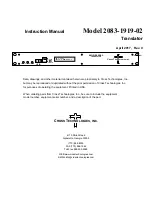
278
Moving the knob to the 12 o’clock position will produce a
effect of 0 as the dynamic modulation source. If “Amt” is a
positive (+)
value, rotating the knob toward the right will
produce a positive change in the effect, and rotating it
toward the left will produce a negative change. (With nega-
tive (–)
values, the opposite effect will result.)
KnobM1 [+] (Knob Mod1: CC#17 [+])
KnobM2 [+] (Knob Mod2: CC#19 [+])
KnobM3 [+] (Knob Mod3: CC#20 [+])
KnobM4 [+] (Knob Mod4: CC#21 [+])
These differ from KnobMod1:CC#17–KnobMod4:CC#21 in
the knob position and direction of the effect. If “Amt” is set
to a positive (+) value, rotating the knob to the far right will
produce an effect of 0 as the dynamic modulation source.
Rotating the knob toward the right will apply an effect only
in the positive direction. (With negative (–) settings, the
opposite effect will result.)
SW 1: CC#80 (SW1 Mod.: CC#80)
SW 2: CC#81 (SW2 Mod.: CC#81)
If you wish to use the [SW1] or [SW2] key as a dynamic
modulation source, make settings in Program, Song, Song
Play, or Sampling modes to set the Controller page parame-
ter “Panel Switch Assign” to the following values respec-
tively: “SW1” to SW1 Mod1 (CC#80), or “SW2” to SW2
Mod2 (CC#81)
(
☞
“SW1/2 Assign”).
The effect will be controlled when you operate the [SW1] or
[SW2] key.
Foot SW: #82 (Foot Switch: CC#82)
If you wish to use an assignable foot switch as a dynamic
modulation source, set “Foot Switch Assign” (Global P2:
Controller 2–1a) to Foot SW (CC#82) (
☞
“Foot Switch
Assign”).
The effect will be controlled when you operate a foot switch
etc. connected to the ASSIGNABLE SWITCH jack.
Tempo
Modulation sources other than Tempo are internally pro-
cessed as a value of 0–127 (–128 – +127). In contrast, Tempo
uses the tempo data (BPM value) of the internal clock or the
external MIDI clock. This means that when “
” is 127 (BPM),
it will have the same result as the maximum value (+127) of
other modulation sources.
About the BPM/MIDI SYNC function
BPM/MIDI SYNC can be used for most effects that have an
LFO, such as 009:St. Wah/Auto Wah, and for some delay-
type effects such as 049:L/C/R BPM Delay. You can apply
modulation that is synchronized to the tempo, or specify the
delay time in terms of a note value so that the effect will syn-
chronize to the tempo of the arpeggiator or sequencer dur-
ing a live performance even if you change the tempo.
Parameters that allow BPM/MIDI SYNC to be used are
marked by a
symbol at their right in the list of param-
eters for each effect.
Example 1. LFO
“BPM/MIDI Sync” On
“Base Note”
“Times” x1
In this case, each cycle of the LFO will be as long as one
quarter note.
If “BPM” is set to MIDI, the effect will synchronize to the
tempo of the arpeggiator or sequencer (or to an external
MIDI clock). If “BPM” is in the range of 40–240, the specified
value will be used.
Example 2. Delay Time
“L Delay Base Note”
“Times” x1
“R Delay Base Note”
“Times” x3
In this case, the delay time of the left channel will be the
duration of an eighth note, and the delay time of the right
channel will be the duration of a sixteenth note triplet.
When “BPM” is set to MIDI, the effect will synchronize to
the tempo of the arpeggiator or sequencer (or to an external
MIDI clock). If “BPM” is in the range of 40–240, the specified
value will be used.
If the tempo, “Base Note,” and “Times” settings in conjunc-
tion would cause the maximum delay time to be exceeded, a
warning such as “Time Over? >OVER!!” will appear in the
display. Please modify your settings so that this setting does
not appear. (The maximum delay time will depend on the
effect type.)
BPM/MIDI Sync: LFO
LFO
BPM/MIDI Sync: Delay Time
Lch
Rch
Dry
Wet
Dry
Wet
Summary of Contents for TRITON Extreme
Page 1: ...2 E ...
Page 11: ...xii ...
Page 111: ...100 9 5 Page Menu Command 0 1A 0 1I 0 1J Program 9 5A ...
Page 185: ...174 ...
Page 215: ...204 ...
Page 281: ...270 ...
Page 349: ...338 ...
Page 350: ...339 ...
Page 351: ...340 ...
Page 352: ...341 ...
Page 353: ...342 ...
















































